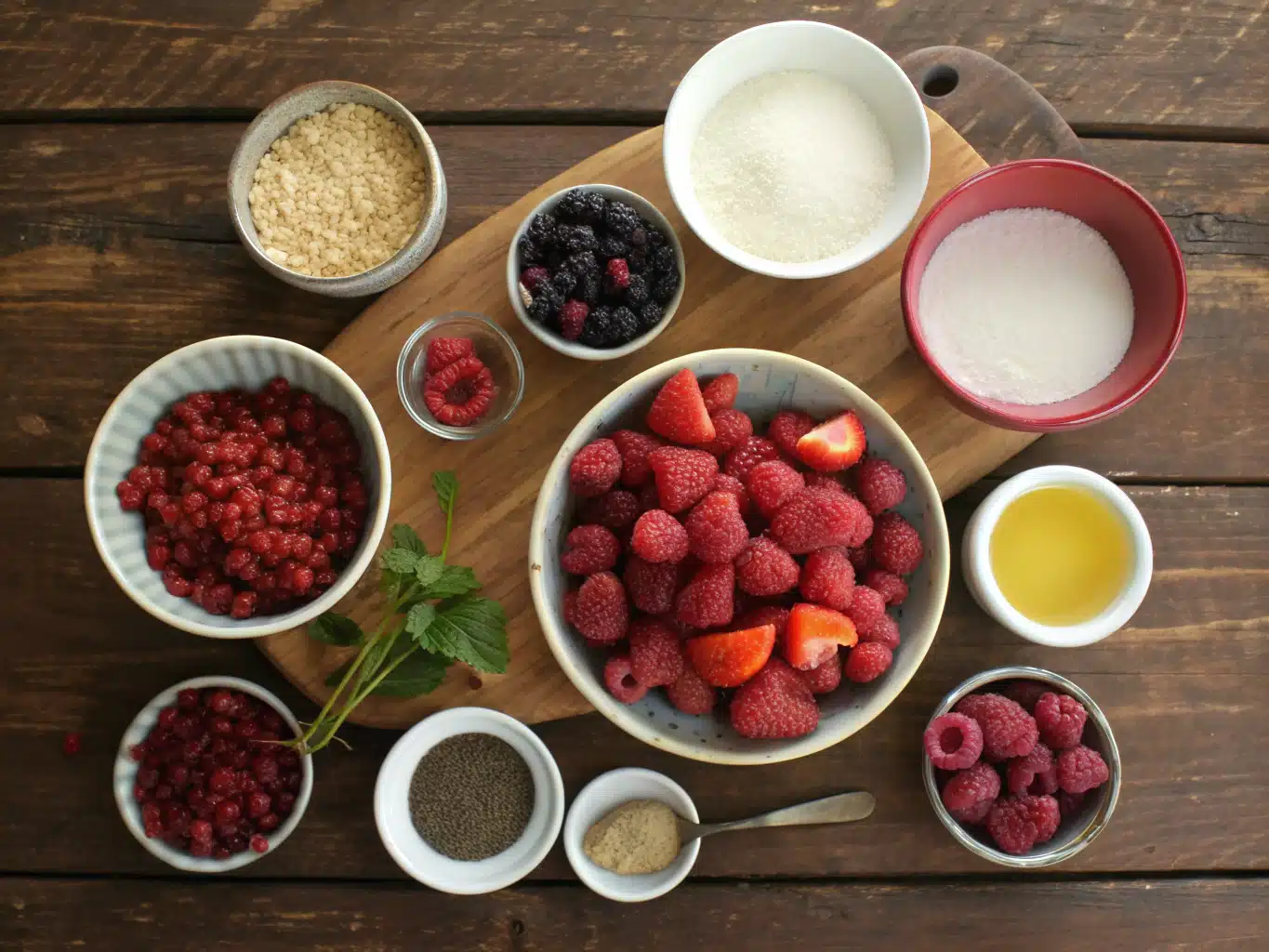
Table of Contents
Ever tried a fruit that tastes like summer and family road trips all at once? That’s the magic of the loganberry. In this article, I’ll guide you through everything you need to know about this delicious berry—from its unique taste and origin to how you can weave it into your kitchen creations. Whether you’re looking to discover what makes the loganberry so special, curious about where it grows, or eager to make a homemade loganberry pie, you’ve come to the right place.
Loganberry Roots and Taste Memories
What Do Loganberries Taste Like?
I remember the first time I tasted a loganberry—I was 14, wandering through my uncle’s backyard in Santa Rosa. Piles of overgrown vines tangled themselves into the fence. He pointed out a hybrid fruit I’d never seen: the loganberry. I took a bite. It was tart. It was sweet. It was like a raspberry and blackberry decided to fall in love and elope. There’s a rich, wine-like depth to the loganberry that sets it apart from other berries. It’s more intense than a raspberry and juicier than a blackberry, but never too sugary. It’s the kind of taste you crave mid-summer while the grill sizzles and the lemonade pitcher sweats on the porch.
Today, loganberry flavor sticks with me in everything from cocktails to jam. The berry fits perfectly into savory applications too—think glazes and reductions for roasted vegetables or even tofu steaks. When I developed my loganberry drink, using that deep berry flavor with a citrus twist sparked memories of picnic blankets and stained fingertips.
A Berry with History
The loganberry isn’t just a fruit; it’s a story of happy accidents. Created by James Harvey Logan in the late 1800s in California, the fruit is a natural cross between a blackberry and a raspberry. This hybrid was never commercially mass-produced like blueberries, but became a hidden gem, loved by locals wherever it grew roots.
What’s fascinating is how this fruit carved its own path through home gardens in the Pacific Northwest and along the Great Lakes. Today, it’s most famously tied with Buffalo, New York, where it became a cultural icon through a sweet, non-carbonated loganberry beverage that still fuels nostalgic memories. Yet, despite its deep American roots, many in the U.S. have never tasted one.
Maybe that’s what makes the loganberry so alluring—it’s a flavor from the past that still waits to be rediscovered.
Crafting Your Own Loganberry Delight
Ingredients List: What You’ll Need

We’re diving into a simple yet flavor-packed recipe today: loganberry jam. This recipe preserves all the vivid, tart-sweet notes of the berry and lets them shine on your morning toast or folded into your favorite plant-based yogurt.
| Ingredient | Details & Substitutes |
|---|---|
| Fresh or frozen loganberries | Use fresh when in season; frozen work well too |
| Organic cane sugar | Can sub with maple syrup for a softer, earthier sweetness |
| Lemon juice | Preserves color and balances acidity |
| Pectin (optional) | Only if you want a firmer set. Jam naturally thickens without it |
The beauty of working with loganberries is that they offer intense depth without complex additives. If you’re looking to make loganberry jam with a twist, adding a cinnamon stick during cooking adds warmth and complexity.
Timing: More Efficient Than You Think
Jam doesn’t have to take hours. Here’s how your time breaks down:
- Prep time: 10 minutes
- Cook time: 25–30 minutes
- Total time: Around 40 minutes
Compared to traditional fruit preserves, this loganberry jam takes about 20% less time and delivers more concentrated flavor with fewer ingredients. It’s a perfect weekend kitchen project that doesn’t require professional canning experience.
Step-by-Step Instructions
- Wash your fresh loganberries and gently pat them dry. If frozen, let them thaw in a strainer overnight.
- In a large saucepan, mix berries and lemon juice over medium heat. Stir occasionally until berries release juice (about 5 minutes).
- Add sugar and stir continuously until dissolved. Let mixture come to a soft boil.
- Lower heat to simmer and mash the berries with a wooden spoon or potato masher for a smoother texture.
- Optional: Add pectin if you like a firmer result. Stir for an additional 10–15 minutes until the jam thickens.
- Skim off foam and pour into sterilized glass jars. Let cool to room temp before storing in fridge or water-bathing for pantry shelf life.
Pro-tip: Always sterilize jars and lids by boiling for at least 10 minutes. This step ensures safety and longer shelf life.
Beyond Jam: Using Loganberries in Unexpected Ways
Loganberries in Savory Dishes
People often typecast the loganberry as a dessert berry, but its bold flavor pops in savory applications too. Over the years, I’ve learned it makes a phenomenal glaze for grilled mushrooms or cauliflower steaks. Combine loganberry juice, balsamic vinegar, and thyme for a sticky, umami-rich reduction. Serve it over your favorite chewy grain—farro or barley work best.
I even created a vegan loganberry barbecue sauce that made my smoked tempeh sliders shine at a summer cookout. Loganberry’s natural acidity softens the density of high-protein plant dishes, making it a chef’s secret weapon. And that’s not just anecdotal—berries like these are loaded with antioxidants and phenolic compounds. In fact, according to Oregon State University’s Extension program, brambleberries retain much of their antioxidant power even after cooking. That’s pure plant-based power.
Baking With Loganberry Love
Beyond its starring role in jam, the loganberry deserves a seat at the pastry table. Swap it into your favorite pie or tart recipes instead of blueberries or strawberries. Its balance of tartness and depth works especially well in vegan crumble bars, muffins, and even breakfast rolls layered with spice-laced puree.
Try folding loganberry compote into your plant-based cheesecake or build a rustic galette with almond flour dough. I once paired a loganberry swirl inside a banana bread loaf with stellar results—the combination of tang and sweetness redefined comfort baking for me.
Where Do Loganberries Grow and Why It Matters
Are Loganberries Only in New York?
Nope, not at all. While the city of Buffalo made them famous through the loganberry drink, which you can replicate with natural ingredients and zero additives using our homemade beverage recipe, the berry’s roots actually trace back to California. Over time, loganberries found their way into the Pacific Northwest, upstate New York, and even parts of the Midwest.
Today, they’re still cultivated in backyard gardens and organic farms. Some specialty growers distribute to local markets during seasonal windows, though their delicate nature means they’re not trucked commercially like apples or grapes.
Growing Your Own Loganberries
If you’re into backyard gardening like I am, here’s great news: loganberries are surprisingly easy to grow. They thrive in USDA zones 6–9 and prefer slightly acidic, well-drained soil. Think of them as low-maintenance once established—they need good airflow and firm support, as they grow on vigorous trailing canes.
You can even train them along fences or raised trellises, much like raspberries. With a little pruning each year and consistent watering, a small plot could yield enough fruit for jam, pie, and beyond.
Set yourself up for success: plant in early spring, give ample compost, and let the bees handle the rest.
Loganberry Recipes You’ll Love to Make and Share
Before we dive into more ways to use loganberries in everyday plant-based cooking, let’s highlight a few standout recipes that celebrate this tart-sweet gem in classic and creative forms. Whether you’re into canning, sipping, or baking, there’s a loganberry recipe that fits the mood—and the season.
Small-Batch Loganberry Jam for Toast and More
If you’ve got a handful of fresh or frozen loganberries, don’t let them go to waste—turn them into loganberry jam with just three ingredients and zero refined sugar. This quick-cook jam bursts with rich berry flavor and pairs beautifully with almond butter toast, plant-based cheese boards, or swirled into non-dairy yogurt.
Tip: Add a splash of lemon juice at the end to brighten the flavor and help preserve color.
Homemade Loganberry Drink Inspired by Buffalo
Buffalo locals know the secret to beating summer heat isn’t lemonade—it’s a cold glass of loganberry drink. Our version is plant-powered and naturally sweetened, capturing the bold essence of the original but with a lighter twist. Serve it over ice, or use it as a base for mocktails with muddled mint or cucumber.
Make a pitcher ahead of time—it’s perfect for picnics, cookouts, or Sunday brunch on the porch.
Vegan Loganberry Pie with a Rustic Crust
Craving something baked and beautiful? This loganberry pie recipe is a plant-based take on a summer classic, featuring juicy berries tucked into a flaky, rustic crust. It’s sweet, tart, and satisfying without overpowering the fruit’s natural character.
Serve it warm with a scoop of vegan vanilla ice cream, or enjoy it chilled for breakfast (we won’t tell).
Frequently Asked Questions
What do loganberries taste like?
Loganberries taste like a tangy mix of raspberry and blackberry. They’re juicier than raspberries and less seedy than blackberries, offering a bold, wine-like depth and pleasant tartness.
Is loganberry only in New York?
No. While the fruity drink popularized the berry in western New York, loganberries originally came from California and are grown in several U.S. regions including Oregon and the Midwest.
Where do loganberries grow?
They prefer moderate climates and are commonly grown in USDA zones 6–9. Loganberries thrive in the Pacific Northwest, New York state, and home gardens throughout the U.S.
Is loganberry a Buffalo thing?
Yes and no. Buffalo gave the loganberry drink cult status, but the berry itself is rooted in California history and found in multiple states. What Buffalo did best was turn it into a regional treasure.
Conclusion: Rediscovering Loganberry Joy
Loganberries might not be lining the shelves of every store, but they’re unforgettable to those lucky enough to know them. Their flavor—bold, tart, and layered—is unmatched in depth and versatility. From backyard bushes to summer stoves, loganberries offer a flavorful adventure whether you’re cooking, baking, or just sipping on something sweet.
So why not bring them into your plant-powered kitchen? With easy ideas like loganberry pie or homemade preserves, you’ll uncover a fruit full of heritage, heart, and palate-pleasing promise.
